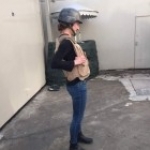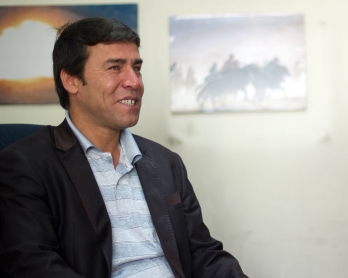Saying goodbye to Kabul
KABUL -- Several weeks before finishing my posting as Kabul bureau chief, I had a dream that olive oil could be the unlikely panacea for my insomnia.
In the dream I walked into an organic supermarket in the Afghan capital’s heavily fortified green zone – imagine a minimalist version of a Whole Foods Market outlet, but surrounded by concrete blast walls and razor wire.
A senior UN official chopping up kale shared the olive oil remedy for my chronic sleeplessness.
And then ... boing! I was awake again.
But at least, for once, I hadn’t been dreaming about a suicide attack.
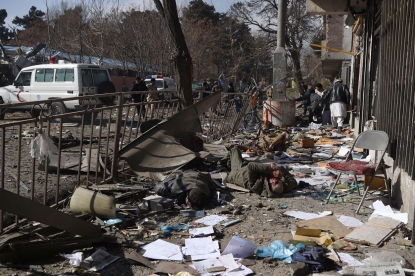 Afghan volunteers carry bodies at the scene of a car bomb exploded in front of the old Ministry of Interior building in Kabul on January 27, 2018. (AFP / Wakil Kohsar)
Afghan volunteers carry bodies at the scene of a car bomb exploded in front of the old Ministry of Interior building in Kabul on January 27, 2018. (AFP / Wakil Kohsar)My struggle with sleep was not unusual given where I was.
I arrived in the Afghan capital in August 2017, less than three months after a massive truck bomb exploded a few hundred meters from AFP’s bureau at the time.
The blast killed more than 150 people and wounded many more, but miraculously my AFP colleagues were unhurt.
It was the deadliest attack in Kabul since the start of the war in 2001, and, as it turned out, a grim portent of things to come during my 18-month posting, which would overlap with the bloodiest phase of the conflict so far.
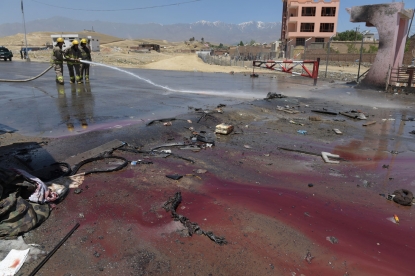 Afghan firefighters wash the road at the scene of a suicide bomb attack in Paghman district in Kabul on May 25, 2016. (AFP / Shah Marai)
Afghan firefighters wash the road at the scene of a suicide bomb attack in Paghman district in Kabul on May 25, 2016. (AFP / Shah Marai)I had been briefed on the risks of working in Afghanistan.
As is required of all AFP journalists before going to a conflict zone, I had completed a hostile environment training course where I learned, among other things, how to use a tourniquet to stop someone from bleeding to death and – my particular favourite – how to poke an attacker in the eye with a pen.
The Afghan war was almost as long as my journalistic career and I had long followed the trajectory of the conflict, but have never actually been there.
I was nervous about going, but mostly just really excited.
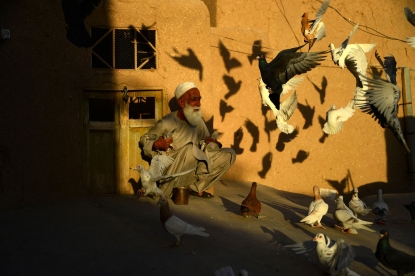 In this photo taken on June 30, 2018, An Afghan pigeon fancier Abdul Ghani, 70, sits as he feeds his pigeons flying from the rooftop of his home in Herat province. (AFP / Hoshang Hashimi)
In this photo taken on June 30, 2018, An Afghan pigeon fancier Abdul Ghani, 70, sits as he feeds his pigeons flying from the rooftop of his home in Herat province. (AFP / Hoshang Hashimi)Kabul is a heavily militarised city, disfigured by disorienting blast walls that protect buildings on the other side from car bombs, but also make many streets look identical.
Armoured military vehicles mounted with machine guns and soldiers or police carrying AK-47s as they patrol the streets or man checkpoints — which must be one of the most dangerous jobs in the world — are everywhere.
And conversations are frequently interrupted by the thwack, thwack, thwack sound of Black Hawk and Chinook helicopters flying overhead.
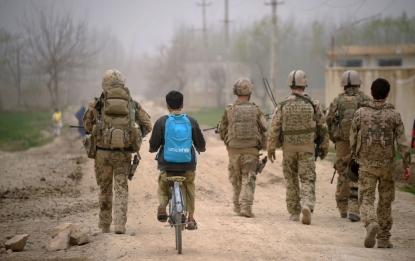 An Afghan boy with an UNICEF schoolbag rides his bicycle past German Soldiers as patrol the area near the DHQ (Char Dara District Police Headquarter) in the province of Kunduz on March 29, 2012. (AFP / Johannes Eisele)
An Afghan boy with an UNICEF schoolbag rides his bicycle past German Soldiers as patrol the area near the DHQ (Char Dara District Police Headquarter) in the province of Kunduz on March 29, 2012. (AFP / Johannes Eisele)What’s even more striking, though, is that regular Afghans still go about their daily lives despite the constant threat of deadly violence -- dropping their children off at school, driving to work, going shopping, selling fruit in the street, hanging out with friends in a café, getting married.
After four decades of war, Kabul is still a functioning city, even cosmopolitan from the point of view of some Afghans living in smaller cities or towns elsewhere in the country that do not have their cafes or shopping malls.
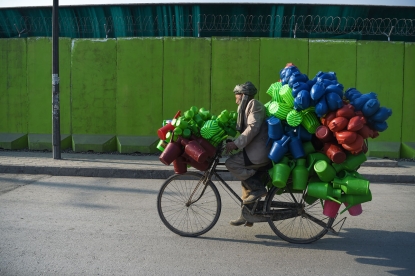 In this photo taken on January 16, 2019, an Afghan vendor rides his bicycle loaded with plastic jars along blast walls in Kabul. (AFP / Wakil Kohsar)
In this photo taken on January 16, 2019, an Afghan vendor rides his bicycle loaded with plastic jars along blast walls in Kabul. (AFP / Wakil Kohsar)But it’s far from normal.
My life in Kabul was frequently interrupted by the sound or a report of an explosion, usually the result of a suicide attacker blowing himself up outside a government or international compound, a magnetic bomb attached to a car detonating, or a militant throwing hand grenades at a security checkpoint.
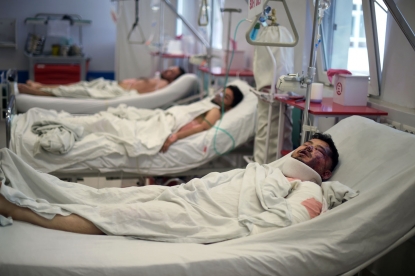 Injured Afghan men receive medical treatment at a hospital in Kabul on June 1, 2017, a day after a massive truck bomb in the Afghan capital. (AFP / Shah Marai)
Injured Afghan men receive medical treatment at a hospital in Kabul on June 1, 2017, a day after a massive truck bomb in the Afghan capital. (AFP / Shah Marai)Such attacks were often claimed by the Taliban or its smaller, but no less pernicious, rival the Islamic State group.
In the first few months of my posting the sound of a blast would make my hands shake and speed up my heart rate, particularly when the explosion was in a place where I knew the death toll would be high, such as a mosque or a wedding hall.
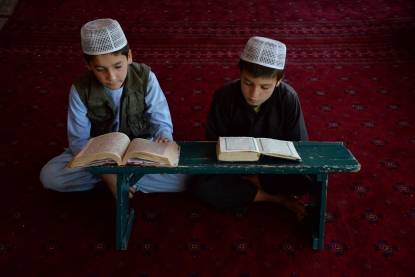 Afghan children read the Koran at a madrasa during the holy month of Ramadan in Ghazni on June 13, 2017. (AFP / Zakeria Hashimi)
Afghan children read the Koran at a madrasa during the holy month of Ramadan in Ghazni on June 13, 2017. (AFP / Zakeria Hashimi)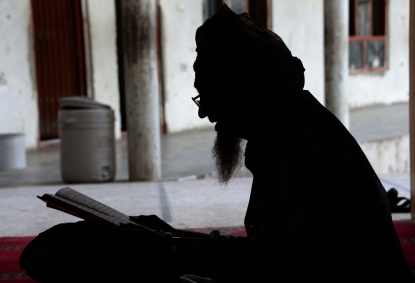 In this photograph taken on June 8, 2017, an Afghan resident reads the Quran in a mosque in Jalalabad. (AFP / Noorullah Shirzada)
In this photograph taken on June 8, 2017, an Afghan resident reads the Quran in a mosque in Jalalabad. (AFP / Noorullah Shirzada)
Sometimes, like when an ambulance packed with explosives blew up in a crowded shopping street in downtown Kabul, killing more than 100 people, the AFP house literally shuddered from the shock waves.
But over time I got more or less used to the explosions and, sadly, writing about them became almost routine, to the extent that finding fresh adjectives and phrases to describe the violence and carnage was a challenge.
Death is never far away in Afghanistan and I had a couple of close calls.
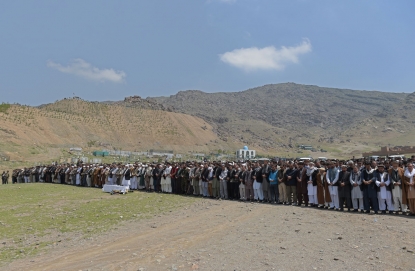 Afghan mourners offer funeral prayers for a victim killed in the April 19 Taliban truck bomb attack, in Kabul on April 20, 2016. (AFP / Shah Marai)
Afghan mourners offer funeral prayers for a victim killed in the April 19 Taliban truck bomb attack, in Kabul on April 20, 2016. (AFP / Shah Marai)In one of them I had gone to a conference at Kabul’s landmark Intercontinental hotel several hours before it was attacked by Taliban militants.
It emerged later that some of the assailants had already checked into the hotel and were most likely in their rooms while I sat in a ground-floor function hall listening to speeches.
The realisation of how physically close I had been to people who given half a chance would have killed me – indeed the hotel attackers had gone from room to room hunting down foreigners -- only hit me a few days later.
Inevitably the conflict and the misery it caused dominated our coverage of Afghanistan. But no country is one-dimensional and I was always searching for stories that would show a different side, one where beauty and joy still existed.
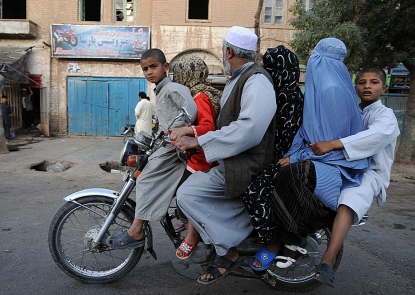 An Afghan man rides a motorcycle with five members of his family in the old city of Herat on August 7, 2009. Afghans go to the polls on August 20 to elect a president for the second time in the history of their turbulent country. (AFP / Shah Marai)
An Afghan man rides a motorcycle with five members of his family in the old city of Herat on August 7, 2009. Afghans go to the polls on August 20 to elect a president for the second time in the history of their turbulent country. (AFP / Shah Marai)Some of my fondest memories of my time there are hiking with a group of Afghan girls and women in the barren mountains around Kabul for a story about female runners or interviewing an Afghan talent show contestant whose uncanny resemblance to Canadian Prime Minister Justin Trudeau had turned him into a household name.
And I will never forget sitting on the roof of a mosque in the western city of Herat watching the sun set over the ancient Citadel after interviewing one of the country’s last traditional glassblowers.
Despite the constant bloodshed, I seemed to be able to distance myself from the misery. It was something that happened to other people — not me, not the people close to me.
 In this photo taken on July 1, 2018, Afghan farmers harvest fresh wheat in a field at Enjil District in Herat province. (AFP / Hoshang Hashimi)
In this photo taken on July 1, 2018, Afghan farmers harvest fresh wheat in a field at Enjil District in Herat province. (AFP / Hoshang Hashimi)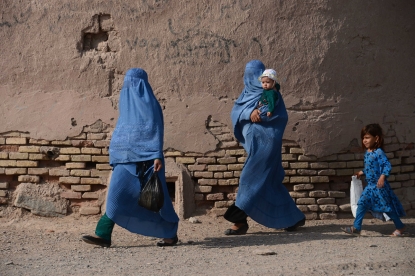 Afghan women walk with their children through the old quarters of Herat on September 20, 2016. (AFP / Aref Karimi)
Afghan women walk with their children through the old quarters of Herat on September 20, 2016. (AFP / Aref Karimi) In this photo taken on February 19, 2018, Afghan horsemen compete during a game of the traditional sport of Buzkashi, in Badakhshan province. (AFP / Sharif Shayeq)
In this photo taken on February 19, 2018, Afghan horsemen compete during a game of the traditional sport of Buzkashi, in Badakhshan province. (AFP / Sharif Shayeq)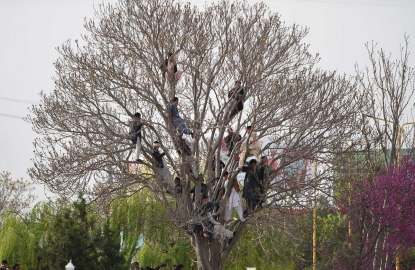 Afghan men look on from a tree as other gather near the Hazrat-e-Ali shrine for Nowruz festivities, which marks the Afghan new year, in Mazar-i-Sharif on March 21, 2019. (AFP / Farshad Usyan)
Afghan men look on from a tree as other gather near the Hazrat-e-Ali shrine for Nowruz festivities, which marks the Afghan new year, in Mazar-i-Sharif on March 21, 2019. (AFP / Farshad Usyan)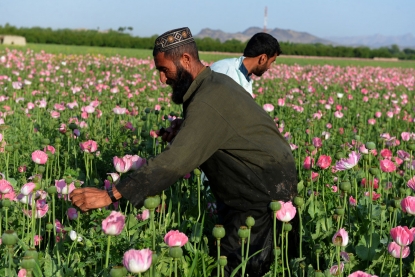 Afghan farmers harvest opium sap from a poppy field in Zari District of Kandahar province on April 12, 2016. (AFP / Javed Tanveer)
Afghan farmers harvest opium sap from a poppy field in Zari District of Kandahar province on April 12, 2016. (AFP / Javed Tanveer)That changed on April 30.
I have a visceral memory of the moment I received a phone call from a distressed colleague telling me “we’ve lost Marai”, AFP’s chief photographer who had just been killed along with eight other journalists in a twin bomb attack in Kabul.
I remember going to the morgue with AFP driver Mohammad Akhtar, me sitting in the back seat because I’m a woman and leaning forward to grip his shoulder, telling him everything would be ok.
It wasn’t. Marai was gone. And Akhtar – Akhtar himself was killed in a suicide attack less than three months later.
It was chaos at the morgue, a very basic facility resembling a large shipping container. Staff were so overwhelmed by the number of bodies being brought from the scene of the attack that black body bags were lined up outside on the asphalt road. At the same time as bodies were arriving, cheaply-made coffins were being brought down from a shed.
Even more disturbing was the familiarity of people with the process of identifying the bodies of colleagues or loved ones. They clearly had done this before, possibly many times.
The tragic deaths of Marai and Akhtar, which came four years after AFP reporter Sardar Ahmad was killed in a Taliban attack on Kabul’s Serena hotel, have taken a toll on everyone in the bureau. But the unfailing support of our AFP colleagues, particularly in Islamabad and Hong Kong, helped us through those dark days.

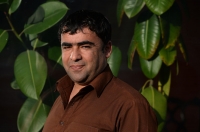
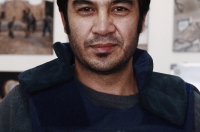
I was amazed by the resilience and professionalism of my Kabul colleagues who, despite the depth of their own personal grief, still managed to care for one another and remain productive.
In the past few months some joy has returned to the office.
Chief photographer Wakil Kohsar recently announced the birth of his first child and video journalist Rateb Noori is excitedly planning his wedding.
Even in war, life goes on.
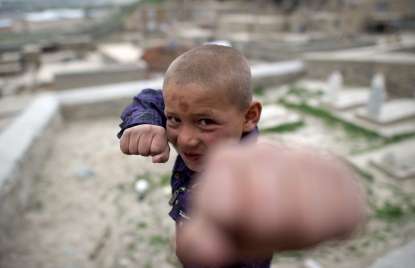 An Afghan boy pretends to box at a graveyard in the city of Kabul on April 17, 2012. (AFP / Johannes Eisele)
An Afghan boy pretends to box at a graveyard in the city of Kabul on April 17, 2012. (AFP / Johannes Eisele)Before leaving Afghanistan someone asked me what I had learned from my experience there.
At the time it struck me as an odd question and I didn’t know how to answer. But on reflection two things stand out.
One is the importance of celebrating life's joys, no matter how big or small. We never know when they might be our last.
And the other is the value of a good night’s sleep.
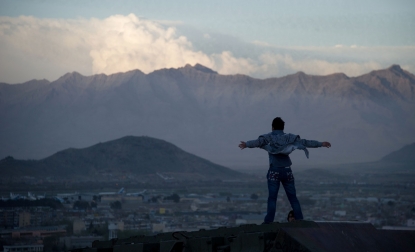 An Afghan boy poses on a old Russian tank as his friend takes his photograph from below on Wazir Akbar Khan hill overlooking Kabul on April 10, 2012. (AFP / Johannes Eisele)
An Afghan boy poses on a old Russian tank as his friend takes his photograph from below on Wazir Akbar Khan hill overlooking Kabul on April 10, 2012. (AFP / Johannes Eisele)


